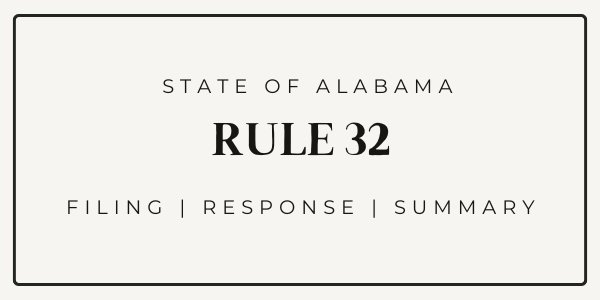Rule 32 Summary
The Rule 32 petition filed in 2024 asked the Baldwin County Circuit Court to vacate Murray Lawrence Jr’s conviction because the State had withheld critical forensic evidence, misrepresented the cause and location of death, used a legally defective indictment, and relied on a theory that was contradicted by the record. The court dismissed the petition without addressing any of the arguments.
What the Petition Presented
The filing set out two central claims.
First, a second autopsy had been performed by the Alabama Department of Forensic Sciences. It was concealed for twenty years and never disclosed to the defense.
Second, the prosecution’s theory of a gunshot murder in Alabama was irreconcilable with the forensic facts recorded by Mississippi coroners, who documented death by ligature strangulation.
Documents also showed that Baldwin County had conducted a secret disinterment and forensic review, authorized by the District Attorney’s Office, with no notice to the defense and no Alabama death certificate to support the gunshot theory used at trial.
What the State Argued in Response
The State did not dispute the accuracy of the second autopsy. Instead, the DA’s office argued that the evidence was not new, that the petition was time barred, that the jury could have believed a gunshot was still possible, and that the court should dismiss the petition without a hearing.
The State avoided the core problem. Its own hidden autopsy contradicted the entire prosecution theory used to convict Murray.
Counter Arguments the Firm Never Filed
1. The Prosecutor Could Not Claim Timeliness While Concealing the Evidence
The State had suppressed the second autopsy for twenty years. A claim is timely when the State hides the very evidence that would have allowed earlier filing.
2. The Second Autopsy Met Every Prong of Rule 32.1(e)
It was unavailable at trial. Unknown to the defense. Unknowable through diligence. Material. And outcome changing.
3. The Forensic Findings Destroyed the Alabama Gunshot Theory
Mississippi coroners documented asphyxiation by ligature.
No bullet.
No bullet track.
No gunshot residue.
The Baldwin County autopsy, concealed for decades, also found no gunshot wound.
4. The Indictment Was Legally Defective
The indictment lacked a grand jury signature and a grand jury number.
This defect alone deprived the trial court of jurisdiction.
5. The Trial Court Dismissed the Petition Without Addressing Any Constitutional Claim
The order contained no findings, no analysis, and no legal reasoning. It simply stated that the petition was dismissed.
While this violated due process, the defect will be overtaken by the new Rule 32.1(b) jurisdiction filing.
What Volunteers Discovered After the 2024 Filing
The volunteer team uncovered several critical points that prior counsel failed to raise.
New discoveries included:
• A complete Rule 32.1(b) jurisdiction filing written by a jailhouse attorney that was never submitted. It identified the jurisdictional defect now known to be fatal.
• Evidence showing Mississippi issued the only valid death certificate, confirming strangulation rather than gunshot.
• Proof that Baldwin County never issued a death certificate, even while prosecuting a claimed Alabama gunshot murder.
• Confirmation that the State had hidden the second autopsy from both defense lawyers.
• Evidence that the DA’s office controlled the secret disinterment, the forensic process, and the narrative, yet presented a contradictory cause of death at trial.
• Proof that none of these issues were ever reviewed by a court because the firm failed to file a reply, failed to request a hearing, and failed to preserve the claims.
• A reconstructed timeline showing the murder occurred during the time change and that investigators never corrected for the shift, which made the timeline used at trial impossible.
Next Step: Separate Rule 32.1(b) Jurisdiction Filing
Jurisdiction was never adjudicated in any Alabama court. The evidence now shows that the crime described at trial did not occur in Alabama and did not occur by gunshot.
A separate Rule 32.1(b) petition will now be filed.
Rule 32.1(b) has no time limit.
A conviction entered without subject matter jurisdiction is void.
It can be challenged at any time.
This new filing will stand on its own and will establish the clean pathway for state and federal review.
